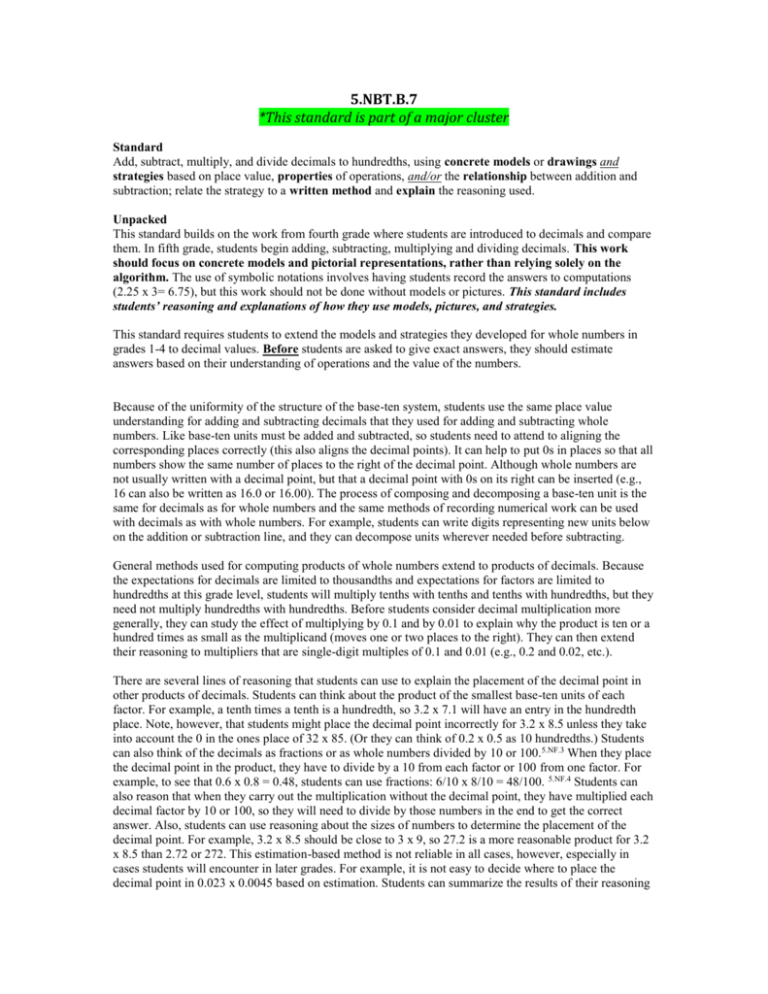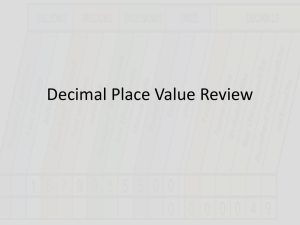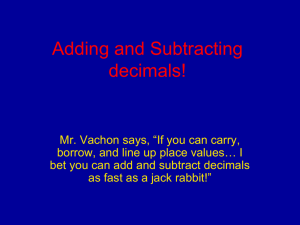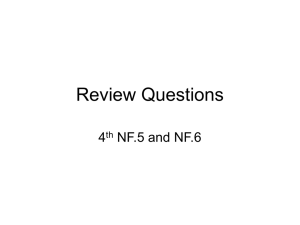5nbtb7 unpacked
advertisement

5.NBT.B.7 *This standard is part of a major cluster Standard Add, subtract, multiply, and divide decimals to hundredths, using concrete models or drawings and strategies based on place value, properties of operations, and/or the relationship between addition and subtraction; relate the strategy to a written method and explain the reasoning used. Unpacked This standard builds on the work from fourth grade where students are introduced to decimals and compare them. In fifth grade, students begin adding, subtracting, multiplying and dividing decimals. This work should focus on concrete models and pictorial representations, rather than relying solely on the algorithm. The use of symbolic notations involves having students record the answers to computations (2.25 x 3= 6.75), but this work should not be done without models or pictures. This standard includes students’ reasoning and explanations of how they use models, pictures, and strategies. This standard requires students to extend the models and strategies they developed for whole numbers in grades 1-4 to decimal values. Before students are asked to give exact answers, they should estimate answers based on their understanding of operations and the value of the numbers. Because of the uniformity of the structure of the base-ten system, students use the same place value understanding for adding and subtracting decimals that they used for adding and subtracting whole numbers. Like base-ten units must be added and subtracted, so students need to attend to aligning the corresponding places correctly (this also aligns the decimal points). It can help to put 0s in places so that all numbers show the same number of places to the right of the decimal point. Although whole numbers are not usually written with a decimal point, but that a decimal point with 0s on its right can be inserted (e.g., 16 can also be written as 16.0 or 16.00). The process of composing and decomposing a base-ten unit is the same for decimals as for whole numbers and the same methods of recording numerical work can be used with decimals as with whole numbers. For example, students can write digits representing new units below on the addition or subtraction line, and they can decompose units wherever needed before subtracting. General methods used for computing products of whole numbers extend to products of decimals. Because the expectations for decimals are limited to thousandths and expectations for factors are limited to hundredths at this grade level, students will multiply tenths with tenths and tenths with hundredths, but they need not multiply hundredths with hundredths. Before students consider decimal multiplication more generally, they can study the effect of multiplying by 0.1 and by 0.01 to explain why the product is ten or a hundred times as small as the multiplicand (moves one or two places to the right). They can then extend their reasoning to multipliers that are single-digit multiples of 0.1 and 0.01 (e.g., 0.2 and 0.02, etc.). There are several lines of reasoning that students can use to explain the placement of the decimal point in other products of decimals. Students can think about the product of the smallest base-ten units of each factor. For example, a tenth times a tenth is a hundredth, so 3.2 x 7.1 will have an entry in the hundredth place. Note, however, that students might place the decimal point incorrectly for 3.2 x 8.5 unless they take into account the 0 in the ones place of 32 x 85. (Or they can think of 0.2 x 0.5 as 10 hundredths.) Students can also think of the decimals as fractions or as whole numbers divided by 10 or 100.5.NF.3 When they place the decimal point in the product, they have to divide by a 10 from each factor or 100 from one factor. For example, to see that 0.6 x 0.8 = 0.48, students can use fractions: 6/10 x 8/10 = 48/100. 5.NF.4 Students can also reason that when they carry out the multiplication without the decimal point, they have multiplied each decimal factor by 10 or 100, so they will need to divide by those numbers in the end to get the correct answer. Also, students can use reasoning about the sizes of numbers to determine the placement of the decimal point. For example, 3.2 x 8.5 should be close to 3 x 9, so 27.2 is a more reasonable product for 3.2 x 8.5 than 2.72 or 272. This estimation-based method is not reliable in all cases, however, especially in cases students will encounter in later grades. For example, it is not easy to decide where to place the decimal point in 0.023 x 0.0045 based on estimation. Students can summarize the results of their reasoning such as those above as specific numerical patterns and then as one general overall pattern such as “the number of decimal places in the product is the sum of the number of decimal places in each factor.” General methods used for computing quotients of whole numbers extend to decimals with the additional issue of placing the decimal point in the quotient. As with decimal multiplication, students can first examine the cases of dividing by 0.1 and 0.01 to see that the quotient becomes 10 times or 100 times as large as the dividend. For example, students can view 7 ÷ 0.1 = as asking how many tenths are in 7.5.NF.7b Because it takes 10 tenths make 1, it takes 7 times as many tenths to make 7, so 7 ÷ 0.1 = 7 x 10 = 70. Or students could note that 7 is 70 tenths, so asking how many tenths are in 7 is the same as asking how many tenths are in 70 tenths, which is 70. In other words, 7 ÷ 0.1 is the same as 70 ÷1. So dividing by 0.1 moves the number 7 one place to the left, the quotient is ten times as big as the dividend. As with decimal multiplication, students can then proceed to more general cases. For example, to calculate 7 ÷ 0.2, students can reason that 0.2 is 2 tenths and 7 is 70 tenths, so asking how many 2 tenths are in 7 is the same as asking how many 2 tenths are in 70 tenths. In other words, 7 ÷ 0.2 is the same as 70 ÷ 2; multiplying both the 7 and the 0.2 by 10 results in the same quotient. Or students could calculate 7 ÷ 0.2 by viewing 0.2 as 2 x 0.1, so they can first divide 7 by 2, which is 3.5, and then divide that result by 0.1, which makes 3.5 ten times as large, namely 35. Dividing by a decimal less than 1 results in a quotient larger than the dividend 5.NF.5 and moves the digits of the dividend one place to the left. Students can summarize the results of their reasoning as specific numerical patterns then as one general overall pattern such as “when the decimal point in the divisor is moved to make a whole number, the decimal point in the dividend should be moved the same number of places.” (Progressions for the CCSSM, Number and Operation in Base Ten, CCSS Writing Team, April 2011, page 17-18) Examples: • 3.6 + 1.7 A student might estimate the sum to be larger than 5 because 3.6 is more than 3 ½ and 1.7 is more than 1 ½. • 5.4 – 0.8 A student might estimate the answer to be a little more than 4.4 because a number less than 1 is being subtracted. • 6 x 2.4 A student might estimate an answer between 12 and 18 since 6 x 2 is 12 and 6 x 3 is 18. Another student might give an estimate of a little less than 15 because s/he figures the answer to be very close, but smaller than 6 x 2 ½ and think of 2 ½ groups of 6 as 12 (2 groups of 6) + 3 (½ of a group of 6). Students should be able to express that when they add decimals they add tenths to tenths and hundredths to hundredths. So, when they are adding in a vertical format (numbers beneath each other), it is important that they write numbers with the same place value beneath each other. This understanding can be reinforced by connecting addition of decimals to their understanding of addition of fractions. Adding fractions with denominators of 10 and 100 is a standard in fourth grade. Example: 4 - 0.3 3 tenths subtracted from 4 wholes. The wholes must be divided into tenths. (solution is 3 and 7/10 or 3.7) Example: A recipe for a cake requires 1.25 cups of milk, 0.40 cups of oil, and 0.75 cups of water. How much liquid is in the mixing bowl? Questions to check for understanding and increase rigor: How is adding and subtracting with decimals similar to adding and subtracting with whole numbers? How are they different? Why does"lining up the decimal points” when you are adding and subtracting with decimals help when finding the answers? Why does this make sense mathematically? Model and explain your reasoning. How can estimation help when you multiply and divide with decimals? Use examples to support your answer. Without doing the calculations, what can you conclude about the products of the following equations? o 3.4 x 6 o 3.45 x 6 o 3.452 x 6 How can you use 45 ÷ 3 = 15 to help you with 4.5 ÷ 3? Model and explain your reasoning. (Extend this thinking with other fact families) When Jamie added .4 + .7 he got .11. Explain to him what he did wrong. When you are explaining, be sure to provide a visual representation to help him understand. Write two decimals when added together have a sum of 18.5.








